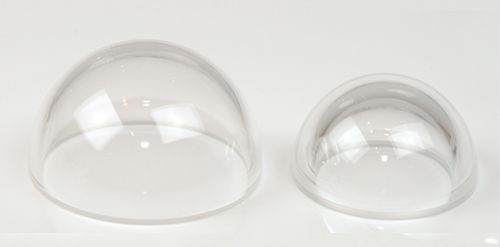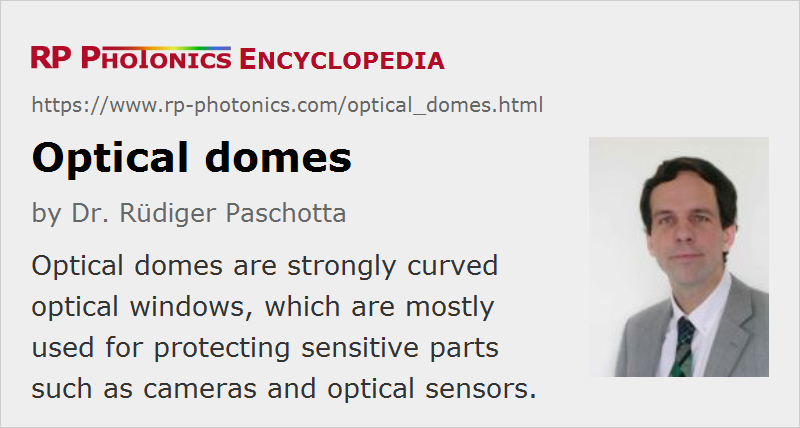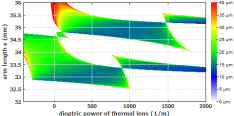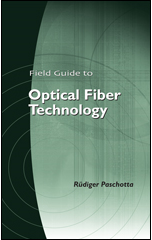Optical Domes
Definition: strongly curved optical windows
German: optische Kuppeln, Glaskuppeln
How to cite the article; suggest additional literature
Author: Dr. Rüdiger Paschotta
Optical domes are a special kind of optical windows, which are strongly curved. For example, they can have the shape of a half-sphere, but domes with custom shapes are also available. Different sizes are available, sometimes with diameters well above 100 mm.
Same optical domes need to transmit only visible light, for example for use with camera systems. They may be made of same high-quality optical glass like BK7 or fused silica. Glass domes are also available for the ultraviolet range, e.g. with UV-grade fused silica. For some applications, plastic optics (e.g. acrylic domes) are appropriate.
Other domes are operated in the infrared (→ infrared optics); for example, such devices are applied in heat-seeking missiles. A particularly robust infrared material is sapphire. Other possible choices, partly allowing for much longer wavelengths, are zinc selenide, germanium, silicon and certain ceramics.
A wide range of viewing directions is often important. The design of a half-sphere with the detector at its center may then be particularly appropriate, because all light getting to these settings are will then have appropriately normal incidence on the dome surface. Under such conditions, there is no beam deflection, and anti-reflection coatings can reach a higher performance than for wide angular ranges.
Protective Domes
Optical domes are mostly used for protecting sensitive systems. For example, optical sensors for LIDAR built into airplanes must be protected with quite robust domes, withstanding the impact of sand or even birds at high velocities. Similarly, domes for submarines and underwater camera and video systems must withstand high pressures.
Due to the priority of protective features, some compromises must be made concerning optical performance. The sometimes harsh operating conditions may anyway not make it possible to preserve a very high optical quality of the exterior surface.
For maximum robustness, some optical domes are equipped with diamond-like hard carbon coatings. There are also other coatings for optical domes, e.g. anti-reflection coatings with particularly high durability, infrared filter coatings and metalized coatings.
Some domes have special mechanical features for precise mounting and sealing.
Suppliers
The RP Photonics Buyer's Guide contains 11 suppliers for optical domes. Among them:


Shanghai Optics
Shanghai Optics manufactures optical domes in a wide variety of substrates, suitable for visible, IR or UV light. Our custom domes are available in sizes from 5 mm to over 200 mm diameter, with custom sizes on request.


Artifex Engineering
Artifex Engineerings offers custom optical domes from glass, quartz and sapphire. These provide high resistance to temperature, shock and scratches. We offer low cost molded domes as well as high quality polished domes for distortion free vision applications. We look forward to your inquiry.


G&H
High numerical aperture (NA) optical domes from G&H are produced using precision tooling. Our product line includes zinc selenide, zinc sulphide, or germanium materials.
CNC processing, combined with extensive metrology capabilities, deliver precision domes for aerospace and military applications.
Optical domes are essentially windows: two parallel surfaces, curved. The dome protects and isolates critical sensors and electronics from the environment with minimal disruption to the optical path.
Optical domes can be found on forward looking infrared systems, seeker head optical systems, in submersibles, and underwater camera systems. Airborne systems must be designed to withstand sand, intense temperature differentials, and other challenging environmental conditions. Diamond-like coatings can be used to improve performance in the field. Submersible optics must likewise be designed to withstand sea salt, spray, and more humid challenging conditions.


Knight Optical
For exceptional protection, our stock and custom-made optical domes are known for their durability within extreme environments. Our material options comprise BK7 (or equivalent) for maximum transmission from 300 nm up to 2 μm, acrylic – commonly used for skylights and meteorology systems – UV fused silica for applications operating in the deeper UV range and sapphire, offering transmission over 80% in the 2–5 μm range.
Questions and Comments from Users
Here you can submit questions and comments. As far as they get accepted by the author, they will appear above this paragraph together with the author’s answer. The author will decide on acceptance based on certain criteria. Essentially, the issue must be of sufficiently broad interest.
Please do not enter personal data here; we would otherwise delete it soon. (See also our privacy declaration.) If you wish to receive personal feedback or consultancy from the author, please contact him e.g. via e-mail.
By submitting the information, you give your consent to the potential publication of your inputs on our website according to our rules. (If you later retract your consent, we will delete those inputs.) As your inputs are first reviewed by the author, they may be published with some delay.
See also: optical windows, infrared optics
and other articles in the category general optics
 |







If you like this page, please share the link with your friends and colleagues, e.g. via social media:
These sharing buttons are implemented in a privacy-friendly way!